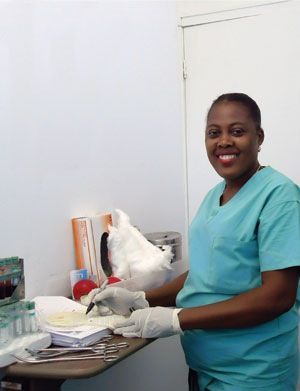 By Treasa Smith, HSC Sr. Clinical Lab Specialist
By Treasa Smith, HSC Sr. Clinical Lab Specialist
Whole blood for transfusion purposes is an important offering of the clinical laboratory at Hôpital Sacré Coeur. The blood bank section of the lab was started in 2005 and is regulated by the Haitian Red Cross headquartered in Port au Prince.
Ms. Jacquelene Elie is the current blood bank coordinator. She began her career at HSC working in Labor and Delivery, but in November of 2008 accepted the position as coordinator of the blood bank. Daily, Ms. Elie performs the screening of each donor by taking an accurate medical history, performing a physical exam and in general verifies the qualification of the donor to safely donate a unit of blood. If a donor qualifies, using proper aseptic technique she collects a unit of blood and properly labels the unit with donor name, a login identifier number, date of collection and date of expiration.
The unit of blood is then immediately refrigerated. In the blood bank, an aliquot of each unit collected is also ABO and Rh typed and screened to determine the unit blood group. The unit is then properly labeled with the unit blood group information.
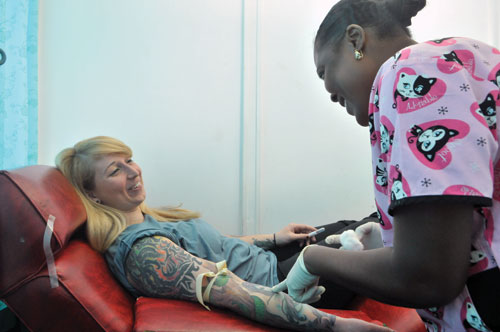 On site, each unit is also screened immediately for syphilis. Then aliquots of each unit are made, labeled and flown to the Haitian Red Cross in PaP for further infection disease testing. The additional screens include testing for hepatitis B and C, HIV and HTLV (Human T-lymphotropic Virus), a known cause of T-cell leukemia and lymphoma.
On site, each unit is also screened immediately for syphilis. Then aliquots of each unit are made, labeled and flown to the Haitian Red Cross in PaP for further infection disease testing. The additional screens include testing for hepatitis B and C, HIV and HTLV (Human T-lymphotropic Virus), a known cause of T-cell leukemia and lymphoma.
Ms. Elie manages the inventory of banked blood which requires strict adherence to dates of collection and expiration and she monitors the number and types of blood group units available for transfusion. For example, because O negative is considered a universal donor unit, when emergencies arise, it becomes important to have O negative units on hand.
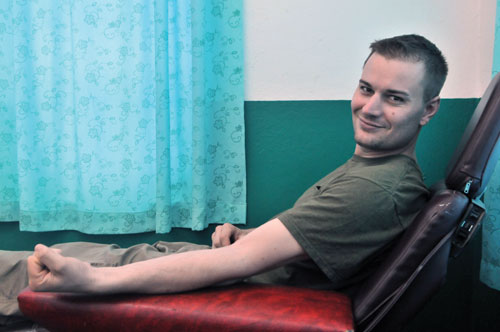 Finally, when units are approaching expiration, Ms. Elie communicates with hospitals, both regional and in Port au Prince to determine if they can use the units before expiration.
Finally, when units are approaching expiration, Ms. Elie communicates with hospitals, both regional and in Port au Prince to determine if they can use the units before expiration.
The dedicated blood bank staff also consists of four blood bank technicians who underwent rigorous training for one month at the Haitian Red Cross facilities in Port au Prince and passed competency exams before being allowed to work as blood bank technicians. The technicians possess the skills and techniques of pretransfusion recipient testing, (ABO and Rh typing and screening of patient blood,) the processing of donor units, and the final cross match of donor units with the patient blood.
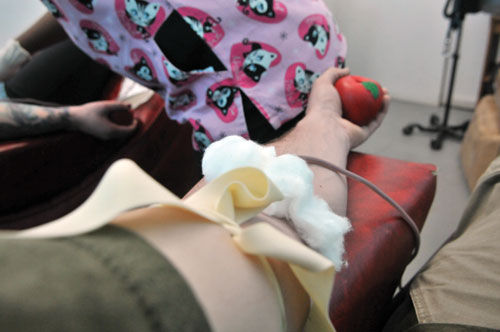 Each step requires attention to detail, carefully written documentation, and the timely and accurate ABO and Rh typing with cross match.
Each step requires attention to detail, carefully written documentation, and the timely and accurate ABO and Rh typing with cross match.
Twelve additional HSC clinical laboratory generalist technicians also contribute to the blood banking process. For example, in 2011 this staff helped to perform ABO and Rh type and screens of 3,393 patients potentially in need of transfusions. If a cross match is requested, these results are then first verified by a blood bank technician, a compatible unit is found and the blood is made available for transfusion to the patient.
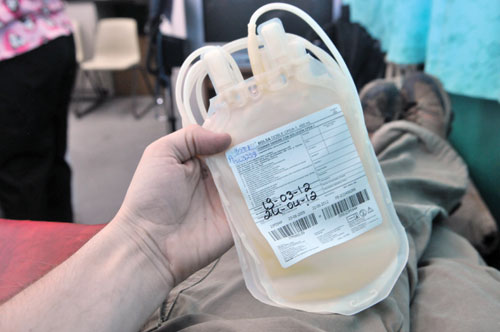 All pregnant and surgerical patient blood are typed and screened, while those patients with anemia, in a crisis such as significant blood loss, or critically ill also require the same careful screens followed by protocol cross matches. In 2011, 1107 donor units were cross matched for transfusion by HSC blood bank technicians.
All pregnant and surgerical patient blood are typed and screened, while those patients with anemia, in a crisis such as significant blood loss, or critically ill also require the same careful screens followed by protocol cross matches. In 2011, 1107 donor units were cross matched for transfusion by HSC blood bank technicians.
Clinical Laboratory Chief Technologist, Moliere Duval works with Ms. Elie to assure blood bank technician coverage, guarantees that reagents are available for the ABO and Rh type and screen and in general assists her in any way necessary to keep the blood bank operational.
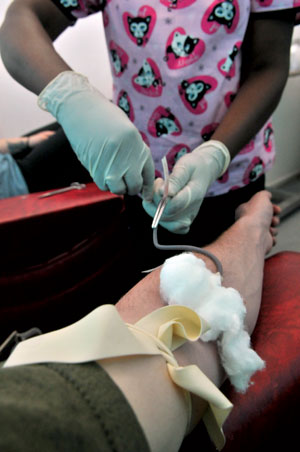 As a final point, blood bank technicians follow a defined protocol before they can even issue a unit of blood. Yet the transfusion process is not over with the release of a unit of blood. It is up to the nursing staff to continue the practice of properly confirming the identity of both the recipient and the compatible donor unit. After the unit of blood is hung for transfusion, it is required the nurses monitor the patient for possible adverse reactions to the unit of blood. Vital signs (temperature, pulse, respiration and blood pressure) should be obtained before transfusion, and checked again within 15 minutes after the transfusion has begun and until one hour following transfusion.
As a final point, blood bank technicians follow a defined protocol before they can even issue a unit of blood. Yet the transfusion process is not over with the release of a unit of blood. It is up to the nursing staff to continue the practice of properly confirming the identity of both the recipient and the compatible donor unit. After the unit of blood is hung for transfusion, it is required the nurses monitor the patient for possible adverse reactions to the unit of blood. Vital signs (temperature, pulse, respiration and blood pressure) should be obtained before transfusion, and checked again within 15 minutes after the transfusion has begun and until one hour following transfusion.
he processes and protocols used in blood bank are in place to promote patient safety. The concept of patient safety must also be practiced on the floors by the nursing staff with the doctor available to intervene if an adverse event occurs. Using other lab tests, the doctor will also monitor the patient to determine if the patient has benefited from the transfusion of blood units.









